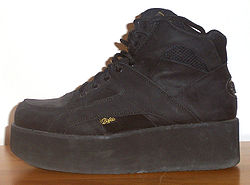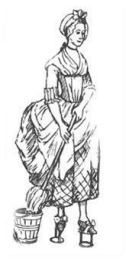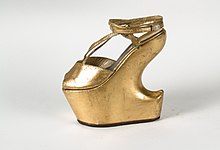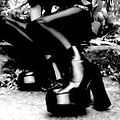Platform shoe




Platform shoesareshoes,boots,orsandalswith a thick sole, usually in the range of 5–10 cm (2–4 in). Platform shoes may also behigh heels,in which case the heel is raised significantly higher than theball of the foot.Extreme heights, of both the sole and heel, can be found infetish footwearsuch asballet boots,where the sole may be up to 20 cm (8 in) high and the heels up to 40 cm (16 in) or more. The sole of a platform shoe can have a continuous uniform thickness, have a wedge, a separate block or astilettoheel. Raising the ankle increases the risk of asprained ankle.[1]
History[edit]
Platform shoes are known in many cultures. The most famous predecessor of platform shoes are the Zoccoli inVeniceof the 15th century, designed with the functional goal of avoiding wet feet when the pavements were flooded. Depending on the current shoe fashion, platform shoes are more or less popular. In the 1970s they were widespread in both genders in Europe. Today, they are preferred by women.[2]
Ancient[edit]

After their use inAncient Greecefor raising the height of important characters in the Greek theatre and their similar use by high-born prostitutes orcourtesansin London in the sixteenth century, platform shoes, calledpattens,are thought to have been worn in Europe in the eighteenth century to avoid the muck of urban streets. Of the same practical origins are Japanesegeta.There may also be a connection to thebuskinsofAncient Rome,which frequently had very thick soles to give added height to the wearer. Another example of a platform shoe that functioned as protection from dirt and grime is the Okobo- "Okobo" referring to the sound that the wooden shoe makes when walking. Dating back to 18th century Japan, the Okobo was worn by maikos, or geishas, during their apprenticeships. Similar to the Okobo, wooden Kabkabs were named after the sound they made upon marble flooring. Worn by Lebanese women between the 14th and 17th centuries, the straps were often made from velvet, leather, or silk while the wooden stilts were decorated with silver or pearl. The ancient Indian Paduka, which translates to footprints of the Gods, was often sported by the upper echelon as a way to mark their status. The wooden platforms were sometimes carved into different animal shapes and decorated with ivory and silver.[3]Inancient China,men wore black boots with very thick soles made from layers of white cloths. This style of boots is often worn today onstage forPeking opera.[4]During theQing dynasty,aristocraticManchuwomen wore a form of platform known as theflowerpot shoeto imitate the gait ofHanwomen withbound feetand theirlotus shoes.[5]
Modern[edit]
Platform shoes enjoyed some popularity in the United States, Europe and the UK from the 1930s to the 1950s but not nearly to the extent of their popularity from the 1960s to the 1980s.
20th century[edit]
1930s–1950s[edit]

In the early 1930s, Moshe (Morris) Kimel designed the first modern version of the platform shoe for actress Marlene Dietrich. Kimel, a Jew, escaped Berlin, Germany, and settled in the United States with his family in 1939 and opened the Kimel shoe factory in Los Angeles. The design soon became very popular amongst Beverly Hills elite. In 1938, The Rainbow was a platform sandal designed by famous shoe designerSalvatore Ferragamo.“The Rainbow” was created and was the first instance of the platform shoe returning in modern days in the West.[citation needed]The platform sandal was designed forJudy Garland,an American singer, actress, andvaudevillian.This shoe was a tribute to Judy Garland's signature song “Over the Rainbow” performed in theWizard of Ozin 1939. The shoe was a crafted using uniquely shaped slabs of cork that were covered in suede to build up the wedge and goldkidskinwas used for the straps.[7]His creation was a result of experimentations with new materials because of wartime rationing duringWorld War II.[citation needed]Traditionally heels were built up with leather, but because of the rationing of leather, he experimented with wood and cork[8]The colors and design of this shoe still resemble modern shoe standards today.
In the 1940s, platforms were designed with a high arch, but as exemplified here, they originated with the heel elevated only slightly above the toes. The platform brings a heavy looking foundation to the wearer that is in direct polarity to thestilettoheel. With its reconfiguration of the arch and structure of attenuated insubstantiality, the high heel suggests the anti-gravitational effect of the danceren pointe.On the contrary, the platform displays weightiness more like the flat steps of modern dance.[9]
In the 1950s, platform shoes were not favored in the same way that they used to be. Fashion returned to the more elegantly shaped shoe.[10]
1960s and 1970s[edit]
A resurgence of interest in platform shoes in fashion began as early as 1967 (appearing in both advertisements and articles in 1970 issues ofSeventeenmagazine), and continued through to 1976 in Europe and Britain, when they suddenly went out of fashion. The fad lasted even further in the US, lasting until as late as the early 1980s. At the beginning of the fad, they were worn primarily by young women in their teens and twenties, and occasionally by younger girls, older women, and (particularly during thediscoera) by young men.[11][12]Platform shoes were considered the "party shoe."[13][unreliable source?]Disco-goers used their shoes to bring attention to themselves on the dance floor.[13][unreliable source?]70s platform shoes were presented in dramatic and showy ways such as with glitter or tiny lights.[13][unreliable source?]
In 1972, at 219 Bowery in Manhattan, Carole Basetta developed a special mold for making platform shoes and was successful in selling custom-made shoes to people such asDavid Bowie,David Johansenof the New York Dolls, and several other punk artists.[14]Although platform shoes did provide added height without the discomfort of spike heels, they seem to have been worn primarily for the sake of attracting attention.[citation needed]Manyglam rockmusicians wore platform shoes as part of their act.[citation needed]Bowie, an icon of glam rock and androgynous fashion in the 1970s, famously wore platform shoes while performing as his alter egoZiggy Stardust.[15][16]
While a wide variety of styles were popular during this period, including boots,espadrilles,oxfords,sneakers,andsandalsof all description, with soles made of wood,cork,or synthetic materials, the most popular style of the late 1960s and early 1970s was a simple quarter-strap sandal with tanwater buffalo-hide straps, on a beige suede-wrapped cork wedge-heel platform sole. These were originally introduced under the brand name Kork-Ease but the extreme popularity supported many imitators. Remarkably, there was very little variation in style, and most of that variation was limited to differences in height.
1980s[edit]
As the fad progressed, manufacturers like Candie's stretched the envelope of what was considered too outrageous to wear, while others, likeFamolareandCherokee of California,introduced "comfort" platforms, designed to combine the added height of platforms with the support and comfort of sneakers, or even orthopedic shoes, and by the time the fad finally fizzled in the late 1980s, girls and women of all ages were wearing them. It may also be a by-product of this fad thatScandinavianclogs,which were considered rather outrageous in the late 1960s and early 1970s, had become classic by the 1980s.
1990s[edit]
Vivienne Westwood,the UK fashion designer, re-introduced the high heeled platform shoe into high fashion in the early1990s;it was while wearing a pair of Super-Elevated Gillie with five-inch platforms and nine-inch heels that the supermodelNaomi Campbellfell on the catwalk at a fashion show.[17]However, they did not catch on quickly and platform shoes only began to resurface in mainstream fashion in the late 1990s, thanks in part to the UK singing group theSpice Girls.The all-girl group was often seen in tall platform sneakers and boots. The footwear brand Buffalo created the famous platform sneakers worn by members of the group.[18]
The United Kingdom (and European) experience of platform shoes was somewhat different from that of the United States.[19]The long, pointed shoes of the early 2000s, giving an elongated look to the foot, have been more popular in the US than in the UK.[according to whom?]
21st century[edit]
2000s[edit]
The platform shoe resurfaced in popularity in the early 2000s when the YSL Tribute Sandal appeared in 2004, quickly gaining popularity by celebrities and the fashion world for its sex appeal and added comfort of a platform sole.[18]The shoe is continued to be released season after season, despite changes in creative directors.[20]
2010s[edit]
During the late2010s,platform boots became fashionable due to a resurgence of interest in1970s fashion.These included so-called "nothing shoes" with clearPerspexsoles, andmule sandals.[21][22]
Notable wearers[edit]
- Gary Glitter
- James Brown
- Dani Filthofgothic rockbandCradle of Filth
- Lady Gagawears platform shoes out in public as well for concerts and performances.
- Spice Girls
- Ariana Grande[23][24]
- Elton Johnhas a large collection of platform shoes, many of which were sold at auction for charity.[25][26]
- Lady Miss Kier
- Richard Kruspeofindustrial metalbandRammstein
- Marilyn Mansonwore platform boots on theMechanical Animalspromo,Grotesk Burlesk,andRock Is Deadtours. For live performances, the prominent wearers were Manson,Skold,John 5,andPogo.
- Carmen Miranda
- Stevie NicksofFleetwood Mac
- Simon Rimmerwears platform shoes at all times due to his different length legs.
- Veruca Salt
- Gene SimmonsfromKiss
- Courtney Stodden
- Charli XCX
Photo gallery[edit]
-
Reconstruction of a 16th-century Venetianchopine.On display at the Shoe Museum in Lausanne.
-
Calcagnetti (Chopine) -Museo Correr
-
Acantabrian albarcasis a rustic wooden shoe in one piece, which has been used particularly by the peasants ofCantabria,northern Spain.
-
The bottom view, showing the "teeth" ofGeta
-
Buffaloplatform trainer
-
An example of a highwedge-heeledsandal
-
Seven inch platform flip flops
-
Azzaro
-
High-heeled platform shoes
-
Acrylic high-heeled platform shoes
-
High-heeled platform shoes
-
Buffalo Boots
-
Leather platform boots
-
1894 painting of a woman wearing platform shoes
-
New Rock platform shoes
-
New Rock platform boots
See also[edit]
References[edit]
- ^O’Keeffe, Linda (2005).Schuhe(in German). Köln: Könemann Verlag.ISBN3-8331-1098-8.
- ^Weber, Paul (1980).Schuhe. Drei Jahrtausende in Bildern(in German). Aarau: AT Verlag.ISBN3-85502-064-7.
- ^“The History of Platform Heels.” Fabulous Platform Shoes, fabulousplatformshoes.com/the-history-of-platform-heels.
- ^Staff (2006–2010)."Characteristics of Peking Opera Costumes(4)".1155815 – Chinese Folklores & Festivals.1155815 – Chinese Folklores & Festivals Website. Archived fromthe originalon 16 May 2013.Retrieved3 June2012.
- ^Mancoff, Debra; Raz-Russo, Michal (26 July 2011)."Attitude and Altitude: A Short History of Shoes".Encyclopædia Britannica Blog – Facts Matter.Encyclopædia Britannica, Inc.Archivedfrom the original on 28 December 2011.Retrieved3 June2012.
- ^Shaw, Lisa.Carmen Miranda's fashion: Turbans, platform shoes and a lot of controversyArchived9 April 2023 at theWayback Machine.The Guardian.
- ^"Salvatore Ferragamo | Sandals | Italian".The Met.Archivedfrom the original on 10 June 2016.Retrieved26 April2016.
- ^DeMello, M. (2009). Feet and footwear: A cultural encyclopedia. Santa Barbara, CA: Greenwood Press/ABC-CLIO.
- ^"Attitude and Altitude: A Short History of Shoes".Britannica Blog.Archivedfrom the original on 25 September 2015.Retrieved26 April2016.
- ^"A brief history of the platform shoe".www.queensofvintage.com.Archivedfrom the original on 9 April 2018.Retrieved8 April2018.
- ^"Footwear - costumes to hire & buy. Fabrics & trims, hats & masks".Archived fromthe originalon 29 August 2010.
- ^"The History Of The Platform Shoe- 70s, 90s, And Today".www.refinery29.com.Archivedfrom the original on 9 January 2019.Retrieved9 January2019.
- ^abc"Fashion Archives: A Look at the History of Platform Shoes".3 October 2015.Archivedfrom the original on 17 April 2018.Retrieved17 April2018.
- ^"Footwear".Archived fromthe originalon 29 August 2010.Retrieved16 March2008.
Picture of a classic 1970s men's platform shoe for going out dancing at a disco from an Internet wardrobe costume rental site.
- ^Singer, Olivia (30 August 2017)."Fashion's Most Powerful Androgynous Icons".www.vogue.co.uk.Archivedfrom the original on 17 April 2018.Retrieved17 April2018.
- ^Hobbs, Julia."David Bowie: Our Style Hero".Archivedfrom the original on 17 April 2018.Retrieved17 April2018.
- ^"BBC News – Vivienne Westwood shoe exhibition at Bowes Museum".bbc.co.uk. 10 June 2011.Archivedfrom the original on 10 November 2018.Retrieved13 February2012.
- ^abAlexander, Ella (13 July 2012)."Most Iconic Shoes".www.vogue.co.uk.Archivedfrom the original on 17 April 2018.Retrieved17 April2018.
- ^Nicholas Kirkwood (1 February 2012)."The World High Heels".Archivedfrom the original on 5 March 2016.Retrieved29 February2012.
- ^Cartner-Morley, Jess (10 May 2011)."The rise of the power platform".the Guardian.Archivedfrom the original on 18 June 2018.Retrieved17 April2018.
- ^Carreon, Justine (23 March 2017)."Make Room in Your Closet for the Barbie Mule".ELLE.Archivedfrom the original on 4 January 2015.Retrieved9 January2019.
- ^"Right Now, the Chicest Thing Is a Nothing Shoe".Vogue.9 June 2016.Archivedfrom the original on 21 April 2019.Retrieved9 January2019.
- ^Drake-Flam, Danielle (31 August 2020)."Ariana Grande Pairs 6-Inch Heels With Purple Leather Bodysuit for MTV VMAs 2020".Yahoo.Archivedfrom the original on 28 October 2020.Retrieved25 October2020.
- ^Regan, Jenny (23 October 2020)."Every Single Look in Ariana Grande's Glam 'Positions' Video: See Photos".Billboard.Archivedfrom the original on 25 October 2020.Retrieved25 October2020.
- ^"Elton John: The Rock & Style Icon Through the Years".Billboard.10 November 2017.Archivedfrom the original on 27 November 2020.Retrieved25 October2020.
- ^"Elton John sells his clothes for charity".News.com.au.12 December 2009.Archivedfrom the original on 29 October 2020.Retrieved25 October2020.


















